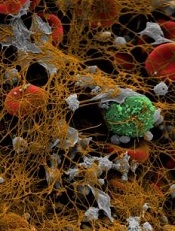
Image by Andre E.X. Brown
Splanchnic venous thrombosis (SVT) may be an indicator of undiagnosed cancer, according to research published in Blood.
The study showed that patients with SVT had a particularly high incidence of myeloproliferative neoplasms (MPNs), liver cancer, and pancreatic cancer.
The presence of SVT also appeared to predict poorer survival in patients with liver and pancreatic cancers. The researchers were unable to calculate the impact of SVT on survival in MPN patients.
“As we learn more about the association between many types of thromboses and cancer, we also want to better understand these more rare clots and how they can perhaps signal a hidden cancer,” said study author Kirstine K. Søgaard, MD, of Aarhus University Hospital in Aarhus, Denmark.
“In this case, we had access to comprehensive data that we believed could provide insights useful to clinicians caring for patients with this condition.”
Dr Søgaard and her colleagues analyzed the medical discharge diagnoses of more than 1191 Danish patients diagnosed with SVT from 1994 to 2011. The researchers followed the patients for a median of 1.6 years, calculating their risk of having a subsequent cancer diagnosis compared to the expected risk in the general population in Denmark.
In all, 183 SVT patients were diagnosed with cancer, for an overall standardized incidence ratio (SIR) of 4.2. More than half of the cancers (n=95) were identified within 3 months of SVT diagnosis. The 3-month absolute risk of cancer was 8%, and the absolute risk at 5 years was 14.8%.
During the first 3 months of follow-up, the SIR for cancer among SVT patients was 33. The SIR fell to 2.7 between 3 and 12 months, then to 2.1 past the 1-year mark.
SIRs were highest for liver and pancreatic cancers and MPNs. The overall SIRs were 138, 21, and 133, respectively.
For MPNs, the SIR was 764 in the first 3 months of SVT diagnosis, 119 from 3 to 12 months, and 88 after the 12-month mark. For liver cancer, the SIR was 1805 in the first 3 months, 92 from 3 to 12 months, and 7.4 after the 12-month mark. For pancreatic cancer, the SIR was 256 in the first 3 months, 0 from 3 to 12 months, and 4 after the 12-month mark.
The researchers also found an excess risk of lymphoma, leukemia, and myelodysplastic syndromes in the first 3 months after SVT diagnosis. After that, the risk did not differ from that of the general population.
Patients with liver or pancreatic cancer had a poor outcome regardless of SVT, but patients with SVT and these cancers had markedly worse 3-month survival outcomes than cancer patients without SVT—44% vs 55% for patients with liver cancer and 33% vs 53% for patients with pancreatic cancer.
Patients with MPNs had a much better prognosis, regardless of SVT. And because so few MPN patients died, the researchers did not analyze the impact of SVT on relative mortality.
“This study is the first to demonstrate, in a large population, that patients who develop splanchnic venous thrombosis are likely to be diagnosed with cancer within a relatively short time period,” Dr Søgaard said. “As we continue to learn more about patients who suffer from these blood clots, it will be important to examine the pros and cons of screening for these hidden cancers.”


